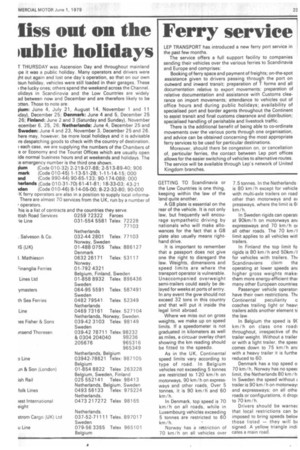Ferry service
Page 25

If you've noticed an error in this article please click here to report it so we can fix it.
LEP TRANSPORT has introduced a new ferry port service in the past few months.
The service offers a full support facility to companies sending their vehicles over the various ferries to Scandinavia and Europe and comprises: Booking of ferry space and payment of freights; on-the-spot assistance given to drivers passing through the port on outward and inward transit; preparation of T forms and all documentation relative to export movements; preparation of relative documentation and assistance with Customs clearance on import movements; attendance to vehicles out of office hours and during public holidays; availability of specialised port and border agents throughout the Continent to assist transit and final customs clearance and distribution; specialised handling of perishable and livestock traffic. There is the additional benefit of being able to co-ordinate movements over the various ports through one organisation, and advice can be obtained concerning the most appropriate ferry services to be used for particular destinations. Moreover, should there be congestion on, or cancellation of, particular ferries, the contact between Lep port offices allows for the easier switching of vehicles to alternative routes. The service will be available through Lep's network of United Kingdom branches.
GETTING TO Scandinavia or the Low Countries is one thing, keeping within the law of the land quite another.
A GB plate is essential on the rear of the vehicle. It is not only law, but frequently will encourage sympathetic driving by nationals who will make allowances for the fact that a GB plate also usually means righthand drive.
It is important to remember that a passport does not give one the right to disregard the law. Weights, dimensions and speed limits are where the transport operator is vulnerable. Unaccompanied overweight semi-trailers could easily be delayed for weeks at ports of entry. In any event the gvw should not exceed 32 tons in this country and that will put it inside the legal limit abroad.
Where we miss out on gross weights, we make up on speed limits. If a speedometer is not graduated in kilometers as well as miles, a circular overlay chart showing the km reading should be fitted to the speedo.
As in the UK. Continental speed limits vary according to type of road. In Belgium vehicles not exceeding 5 tonnes are restricted to 120 km/h on motorways, 90 km/h on expressways and other roads. Over 5 tonnes, it is 90 km /h and 60 km/h.
In Denmark, top speed is 70 km/h on all roads, while in Luxembourg vehicles exceeding 5 tonnes are restricted to 60 km/h.
Norway has a restriction of 70 km /h on all vehicles over 7.5 tonnes. In the Netherlands is 80 km /h except for vehicle with multi-axle trailers on road other than motorways and e) pressways, where the limit is km/h, In Sweden rigids can operati at 90km / h on motorways am expressways and 70 km/h oi all other roads. The 70 km/1 limit applies to all vehicles witl trailers.
In Finland the top limit fo rigids is 80 km/h and 50km /1 for vehicles with trailers. Thi Scandinavians claim the operating at lower speeds an( higher gross weights make; them more energy-efficient thar many other European countries Passenger vehicle operator; have their own restrictions. TM Continental peculiarity o coaches trailing light or heavl trailers adds another element t( the law.
In Belgium the speed is 9( km /h on class one road: throughout, irrespective of thi trailer weight. Without a trailer or with a light trailer, the speec .comes down to 75 km /h an with a heavy trailer it is furthe reduced to 60.
Denmark has a top speed o 70 km/h, Norway has no spee( limit, the Netherlands 80 km / h In Sweden the speed without ( trailer is 90 km/h on motorway: and expressways; on all othe roads or configurations, it drop: to 70 km /h.
Drivers should be warne( that local restrictions can b( imposed to bring speeds belov those listed — they will b( signed. A yellow triangle indi cates a main road.












































































































